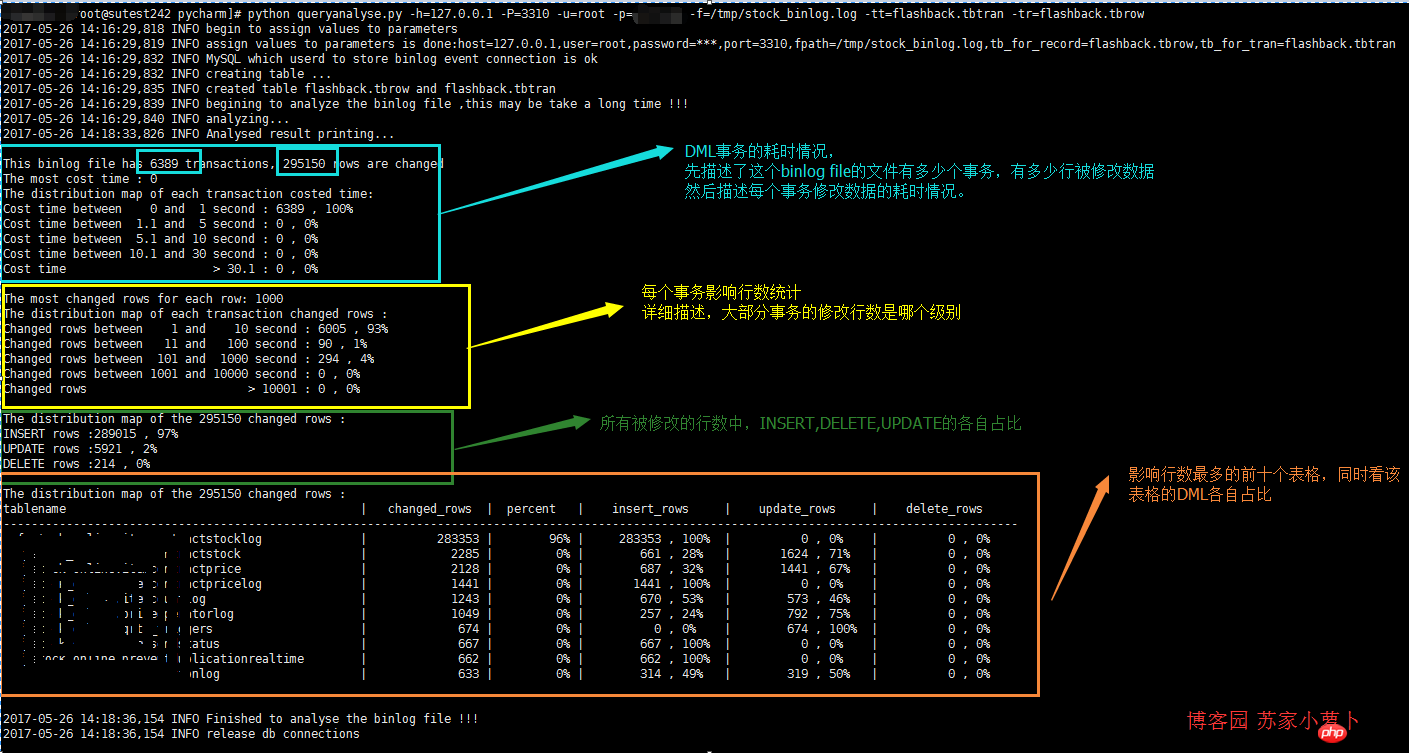?最近寫完mysql flashback,突然發現還有有這種使用場景:有些情況下,可能會統計在某個時間段內,mysql修改了多少數據量?發生了多少事務?主要是哪些mysql發生變動?變動的數量是怎么樣的??但是卻不需要行記錄的修改內容,只需要了解 行數據的 變動情況。故也整理了下。
昨晚寫的腳本,因為個人mysql能力有限,本來想這不發這文,后來想想,沒準會有哪位園友給出優化建議。
1 實現內容?
? ? 有些情況下,可能會統計在某個時間段內,mysql修改了多少數據量?發生了多少事務?主要是哪些表格發生變動?變動的數量是怎么樣的??但是卻不需要行記錄的修改內容,只需要了解 行數據的 變動情況。
? ? 這些情況部分可以通過監控來大致了解,但是也可以基于binlog來全盤分析,binlog的格式是row模式。
? ? 在寫flashback的時候,順帶把這個也寫了個腳步,使用python編寫,都差不多原理,只是這個簡單些,介于個人python弱的不行,性能可能還有很大的提升空間,也希望園友能協助優化下。
? ? 先貼python腳步的分析結果圖如下,分為4個部分:事務耗時情況、事務影響行數情況、DML行數情況以及操作最頻繁表格情況。

2 腳本簡單描述
? ? 腳本依賴的模塊中,pymysql需要自行mysql。
? ? 創建類queryanalyse,其中有5個mysql定義:_get_db、create_tab、rowrecmysql、binlogdesc跟closeconn。
2.1?_get_db
? ? 該函數用來解析輸入參數值,參數值一共有7個,都是必須填寫的。分別為host,user,password,port,table name mysql transmysql,table name for records,對應的簡寫如下:
ALL options need to assign:
-h? ? : host, the database host,which database will store the results after analysis
-u? ? : user, the db user
-p? ? : password, the db user’s password
-P? ? : port, the db port
-f? ? : mysql path, the binlog file
-tr? ? : table name for record , the table name to store the row record
-tt? ? : table name for transaction, the table name to store transactions
? ? 比如,執行腳本:python queryanalyse.py -h=127.0.0.1 -P=3310 -u=root -p=password -f=/tmp/stock_binlog.log -tt=flashback.tbtran -tr=flashback.tbrow,該函數負責處理各個選項的參數值情況,并存儲。
2.2?create_tab
? ? 創建兩個表格,分別用來存儲 binlog file文件的分析結果。一個用來存儲事務的執行開始時間跟結束時間,由選項 -tt來賦值表名;一個是用來存儲每一行記錄的修改情況,由選項 -tr來賦值表名。
? ? 事務表記錄內容:事務的開始時間及事務的結束時間。
? ? 行記錄表的內容:庫名,表名,DML類型以及事務對應事務表的編號。
root@localhost:mysql3310.sock 14:42:29 [flashback]>show create table tbrow G*************************** 1. row *************************** Table: tbrowCreate Table: CREATE TABLE `tbrow` ( `auto_id` int(10) unsigned NOT NULL AUTO_INCREMENT, `sqltype` int(11) NOT NULL COMMENT '1 is insert,2 is update,3 is delete', `tran_num` int(11) NOT NULL COMMENT 'the transaction number', `dbname` varchar(50) NOT NULL, `tbname` varchar(50) NOT NULL, PRIMARY KEY (`auto_id`), KEY `sqltype` (`sqltype`), KEY `dbname` (`dbname`), KEY `tbname` (`tbname`) ) ENGINE=InnoDB AUTO_INCREMENT=295151 DEFAULT CHARSET=utf81 row in set (0.00 sec) root@localhost:mysql3310.sock 14:42:31 [flashback]>SHOW CREATE TABLE TBTRAN G*************************** 1. row *************************** Table: TBTRANCreate Table: CREATE TABLE `tbtran` ( `auto_id` int(10) unsigned NOT NULL AUTO_INCREMENT, `begin_time` datetime NOT NULL, `end_time` datetime NOT NULL, PRIMARY KEY (`auto_id`) ) ENGINE=InnoDB AUTO_INCREMENT=6390 DEFAULT CHARSET=utf81 row in set (0.00 sec)
2.3?rowrecord
? ? 重點函數,分析binlog文件內容。這里有幾個規律:
-
每個事務的結束點,是以 ‘Xid = ‘ 來查找
-
事務的開始時間,是事務內的第一個?‘Table_mysql‘ 行里邊的時間
-
事務的結束時間,是以 ‘Xid = ‘所在行的 里邊的時間
-
每個行數據是屬于哪個表格,是以 ‘Table_map’來查找
-
DML的類型是按照 行記錄開頭的情況是否為:’### INSERT INTO’ ?、’### UPDATE’ 、’### DELETE FROM’?
-
注意,單個事務可以包含多個表格多種DML多行數據修改的情況。
2.4?binlogdesc
? ? 描述分析結果,簡單4個SQL分析。
-
分析修改行數據的 事務耗時情況
-
分析修改行數據的 事務影響行數情況
-
分析DML分布情況
-
分析 最多DML操作的表格 ,取前十個分析
2.5?closeconn
? ? 關閉數據庫連接。
3 使用說明
? ? 首先,確保python安裝了pymysql模塊,把python腳本拷貝到文件?queryanalyse.py。
? ? 然后,把要分析的binlog文件先用 mysqlbinlog 指令分析存儲,具體binlog的文件說明,可以查看之前的博文:關于binary log那些事——認真碼了好長一篇。mysqlbinlog的指令使用方法,可以詳細查看文檔:mysqldev.mysql.com/doc/refman/5.7/en/mysqlbinlog.html?。
? ? 比較常用通過指定開始時間跟結束時間來分析 binlog文件。
mysqlbinlog –start-datetime=’2017-04-23 00:00:03′ –stop-datetime=’2017-04-23 00:30:00′ –base64-output=decode-rows -v /data/mysql/logs/mysql-bin.007335 > /tmp/binlog_test.log? ?
? ? 分析后,可以把這個 binlog_test.log文件拷貝到其他空閑服務器執行分析,只需要有個空閑的DB來存儲分析記錄即可。
? ? 假設這個時候,拷貝 binlog_test.log到測試服務器上,測試服務器上的數據庫可以用來存儲分析內容,則可以執行python腳本了,注意要進入到python腳本的目錄中,或者指定python腳本路徑。
python queryanalyse.py -h=127.0.0.1 -P=3310 -u=root -p=password -f=?/tmp/binlog_test.log?-tt=flashback.tbtran -tr=flashback.tbrow
? ? 沒了,就等待輸出吧。
??? 性能是硬傷,在虛擬機上測試,大概500M的binlog文件需要分析2-3min,有待提高!
4 python腳本
1 import pymysql 2 from pymysql.cursors import DictCursor 3 import re 4 import os 5 import sys 6 import datetime 7 import time 8 import logging 9 import importlib 10 importlib.reload(logging) 11 logging.basicConfig(level=logging.DEBUG,format='%(asctime)s %(levelname)s %(message)s ') 12 13 14 usage=''' usage: python [script's path] [option] 15 ALL options need to assign: 16 17 -h : host, the database host,which database will store the results after analysis 18 -u : user, the db user 19 -p : password, the db user's password 20 -P : port, the db port 21 -f : file path, the binlog file 22 -tr : table name for record , the table name to store the row record 23 -tt : table name for transaction, the table name to store transactions 24 Example: python queryanalyse.py -h=127.0.0.1 -P=3310 -u=root -p=password -f=/tmp/stock_binlog.log -tt=flashback.tbtran -tr=flashback.tbrow 25 26 ''' 27 28 class queryanalyse: 29 def init(self): 30 #初始化 31 self.host='' 32 self.user='' 33 self.password='' 34 self.port='3306' 35 self.fpath='' 36 self.tbrow='' 37 self.tbtran='' 38 39 self._get_db() 40 logging.info('assign values to parameters is done:host={},user={},password=***,port={},fpath={},tb_for_record={},tb_for_tran={}'.format(self.host,self.user,self.port,self.fpath,self.tbrow,self.tbtran)) 41 42 self.mysqlconn = pymysql.connect(host=self.host, user=self.user, password=self.password, port=self.port,charset='utf8') 43 self.cur = self.mysqlconn.cursor(cursor=DictCursor) 44 logging.info('MySQL which userd to store binlog event connection is ok') 45 46 self.begin_time='' 47 self.end_time='' 48 self.db_name='' 49 self.tb_name='' 50 51 def _get_db(self): 52 #解析用戶輸入的選項參數值,這里對password的處理是明文輸入,可以自行處理成是input格式, 53 #由于可以拷貝binlog文件到非線上環境分析,所以password這塊,沒有特殊處理 54 logging.info('begin to assign values to parameters') 55 if len(sys.argv) == 1: 56 print(usage) 57 sys.exit(1) 58 elif sys.argv[1] == '--help': 59 print(usage) 60 sys.exit() 61 elif len(sys.argv) > 2: 62 for i in sys.argv[1:]: 63 _argv = i.split('=') 64 if _argv[0] == '-h': 65 self.host = _argv[1] 66 elif _argv[0] == '-u': 67 self.user = _argv[1] 68 elif _argv[0] == '-P': 69 self.port = int(_argv[1]) 70 elif _argv[0] == '-f': 71 self.fpath = _argv[1] 72 elif _argv[0] == '-tr': 73 self.tbrow = _argv[1] 74 elif _argv[0] == '-tt': 75 self.tbtran = _argv[1] 76 elif _argv[0] == '-p': 77 self.password = _argv[1] 78 else: 79 print(usage) 80 81 def create_tab(self): 82 #創建兩個表格:一個用戶存儲事務情況,一個用戶存儲每一行數據修改的情況 83 #注意,一個事務可以存儲多行數據修改的情況 84 logging.info('creating table ...') 85 create_tb_sql ='''CREATE TABLE IF NOT EXISTS {} ( 86 `auto_id` int(10) unsigned NOT NULL AUTO_INCREMENT, 87 `begin_time` datetime NOT NULL, 88 `end_time` datetime NOT NULL, 89 PRIMARY KEY (`auto_id`) 90 ) ENGINE=InnoDB DEFAULT CHARSET=utf8; 91 CREATE TABLE IF NOT EXISTS {} ( 92 `auto_id` int(10) unsigned NOT NULL AUTO_INCREMENT, 93 `sqltype` int(11) NOT NULL COMMENT '1 is insert,2 is update,3 is delete', 94 `tran_num` int(11) NOT NULL COMMENT 'the transaction number', 95 `dbname` varchar(50) NOT NULL, 96 `tbname` varchar(50) NOT NULL, 97 PRIMARY KEY (`auto_id`), 98 KEY `sqltype` (`sqltype`), 99 KEY `dbname` (`dbname`),100 KEY `tbname` (`tbname`)101 ) ENGINE=InnoDB DEFAULT CHARSET=utf8;102 truncate table {};103 truncate table {};104 '''.format(self.tbtran,self.tbrow,self.tbtran,self.tbrow)105 106 self.cur.execute(create_tb_sql)107 logging.info('created table {} and {}'.format(self.tbrow,self.tbtran))108 109 def rowrecord(self):110 #處理每一行binlog111 #事務的結束采用 'Xid =' 來劃分112 #分析結果,按照一個事務為單位存儲提交一次到db113 try:114 tran_num=1 #事務數115 record_sql='' #行記錄的insert sql116 tran_sql='' #事務的insert sql117 118 self.create_tab()119 120 with open(self.fpath,'r') as binlog_file:121 logging.info('begining to analyze the binlog file ,this may be take a long time !!!')122 logging.info('analyzing...')123 124 for bline in binlog_file:125 126 if bline.find('Table_map:') != -1:127 l = bline.index('server')128 n = bline.index('Table_map')129 begin_time = bline[:l:].rstrip(' ').replace('#', '20')130 131 if record_sql=='':132 self.begin_time = begin_time[0:4] + '-' + begin_time[4:6] + '-' + begin_time[6:]133 134 self.db_name = bline[n::].split(' ')[1].replace('`', '').split('.')[0]135 self.tb_name = bline[n::].split(' ')[1].replace('`', '').split('.')[1]136 bline=''137 138 elif bline.startswith('### INSERT INTO'):139 record_sql=record_sql+"insert into {}(sqltype,tran_num,dbname,tbname) VALUES (1,{},'{}','{}');".format(self.tbrow,tran_num,self.db_name,self.tb_name)140 141 elif bline.startswith('### UPDATE'):142 record_sql=record_sql+"insert into {}(sqltype,tran_num,dbname,tbname) VALUES (2,{},'{}','{}');".format(self.tbrow,tran_num,self.db_name,self.tb_name)143 144 elif bline.startswith('### DELETE FROM'):145 record_sql=record_sql+"insert into {}(sqltype,tran_num,dbname,tbname) VALUES (3,{},'{}','{}');".format(self.tbrow,tran_num,self.db_name,self.tb_name)146 147 elif bline.find('Xid =') != -1:148 149 l = bline.index('server')150 end_time = bline[:l:].rstrip(' ').replace('#', '20')151 self.end_time = end_time[0:4] + '-' + end_time[4:6] + '-' + end_time[6:]152 tran_sql=record_sql+"insert into {}(begin_time,end_time) VALUES ('{}','{}')".format(self.tbtran,self.begin_time,self.end_time)153 154 self.cur.execute(tran_sql)155 self.mysqlconn.commit()156 record_sql = ''157 tran_num += 1158 159 except Exception:160 return 'funtion rowrecord error'161 162 def binlogdesc(self):163 sql=''164 t_num=0165 r_num=0166 logging.info('Analysed result printing...n')167 #分析總的事務數跟行修改數量168 sql="select 'tbtran' name,count(*) nums from {} union all select 'tbrow' name,count(*) nums from {};".format(self.tbtran,self.tbrow)169 self.cur.execute(sql)170 rows=self.cur.fetchall()171 for row in rows:172 if row['name']=='tbtran':173 t_num = row['nums']174 else:175 r_num = row['nums']176 print('This binlog file has {} transactions, {} rows are changed '.format(t_num,r_num))177 178 # 計算 最耗時 的單個事務179 # 分析每個事務的耗時情況,分為5個時間段來描述180 # 這里正常應該是 以毫秒來分析的,但是binlog中,只精確時間到second181 sql='''select 182 count(case when cost_sec between 0 and 1 then 1 end ) cos_1,183 count(case when cost_sec between 1.1 and 5 then 1 end ) cos_5,184 count(case when cost_sec between 5.1 and 10 then 1 end ) cos_10,185 count(case when cost_sec between 10.1 and 30 then 1 end ) cos_30,186 count(case when cost_sec >30.1 then 1 end ) cos_more,187 max(cost_sec) cos_max188 from 189 (190 select 191 auto_id,timestampdiff(second,begin_time,end_time) cost_sec192 from {}193 ) a;'''.format(self.tbtran)194 self.cur.execute(sql)195 rows=self.cur.fetchall()196 197 for row in rows:198 print('The most cost time : {} '.format(row['cos_max']))199 print('The distribution map of each transaction costed time: ')200 print('Cost time between 0 and 1 second : {} , {}%'.format(row['cos_1'],int(row['cos_1']*100/t_num)))201 print('Cost time between 1.1 and 5 second : {} , {}%'.format(row['cos_5'], int(row['cos_5'] * 100 / t_num)))202 print('Cost time between 5.1 and 10 second : {} , {}%'.format(row['cos_10'], int(row['cos_10'] * 100 / t_num)))203 print('Cost time between 10.1 and 30 second : {} , {}%'.format(row['cos_30'], int(row['cos_30'] * 100 / t_num)))204 print('Cost time > 30.1 : {} , {}%n'.format(row['cos_more'], int(row['cos_more'] * 100 / t_num)))205 206 # 計算 單個事務影響行數最多 的行數量207 # 分析每個事務 影響行數 情況,分為5個梯度來描述208 sql='''select 209 count(case when nums between 0 and 10 then 1 end ) row_1,210 count(case when nums between 11 and 100 then 1 end ) row_2,211 count(case when nums between 101 and 1000 then 1 end ) row_3,212 count(case when nums between 1001 and 10000 then 1 end ) row_4,213 count(case when nums >10001 then 1 end ) row_5,214 max(nums) row_max215 from 216 (217 select 218 count(*) nums219 from {} group by tran_num220 ) a;'''.format(self.tbrow)221 self.cur.execute(sql)222 rows=self.cur.fetchall()223 224 for row in rows:225 print('The most changed rows for each row: {} '.format(row['row_max']))226 print('The distribution map of each transaction changed rows : ')227 print('Changed rows between 1 and 10 second : {} , {}%'.format(row['row_1'],int(row['row_1']*100/t_num)))228 print('Changed rows between 11 and 100 second : {} , {}%'.format(row['row_2'], int(row['row_2'] * 100 / t_num)))229 print('Changed rows between 101 and 1000 second : {} , {}%'.format(row['row_3'], int(row['row_3'] * 100 / t_num)))230 print('Changed rows between 1001 and 10000 second : {} , {}%'.format(row['row_4'], int(row['row_4'] * 100 / t_num)))231 print('Changed rows > 10001 : {} , {}%n'.format(row['row_5'], int(row['row_5'] * 100 / t_num)))232 233 # 分析 各個行數 DML的類型情況234 # 描述 delete,insert,update的分布情況235 sql='select sqltype ,count(*) nums from {} group by sqltype ;'.format(self.tbrow)236 self.cur.execute(sql)237 rows=self.cur.fetchall()238 239 print('The distribution map of the {} changed rows : '.format(r_num))240 for row in rows:241 242 if row['sqltype']==1:243 print('INSERT rows :{} , {}% '.format(row['nums'],int(row['nums']*100/r_num)))244 if row['sqltype']==2:245 print('UPDATE rows :{} , {}% '.format(row['nums'],int(row['nums']*100/r_num)))246 if row['sqltype']==3:247 print('DELETE rows :{} , {}%n '.format(row['nums'],int(row['nums']*100/r_num)))248 249 # 描述 影響行數 最多的表格250 # 可以分析是哪些表格頻繁操作,這里顯示前10個table name251 sql = '''select 252 dbname,tbname ,253 count(*) ALL_rows,254 count(*)*100/{} per,255 count(case when sqltype=1 then 1 end) INSERT_rows,256 count(case when sqltype=2 then 1 end) UPDATE_rows,257 count(case when sqltype=3 then 1 end) DELETE_rows258 from {} 259 group by dbname,tbname 260 order by ALL_rows desc 261 limit 10;'''.format(r_num,self.tbrow)262 self.cur.execute(sql)263 rows = self.cur.fetchall()264 265 print('The distribution map of the {} changed rows : '.format(r_num))266 print('tablename'.ljust(50),267 '|','changed_rows'.center(15),268 '|','percent'.center(10),269 '|','insert_rows'.center(18),270 '|','update_rows'.center(18),271 '|','delete_rows'.center(18)272 )273 print('-------------------------------------------------------------------------------------------------------------------------------------------------')274 for row in rows:275 print((row['dbname']+'.'+row['tbname']).ljust(50),276 '|',str(row['ALL_rows']).rjust(15),277 '|',(str(int(row['per']))+'%').rjust(10),278 '|',str(row['INSERT_rows']).rjust(10)+' , '+(str(int(row['INSERT_rows']*100/row['ALL_rows']))+'%').ljust(5),279 '|',str(row['UPDATE_rows']).rjust(10)+' , '+(str(int(row['UPDATE_rows']*100/row['ALL_rows']))+'%').ljust(5),280 '|',str(row['DELETE_rows']).rjust(10)+' , '+(str(int(row['DELETE_rows']*100/row['ALL_rows']))+'%').ljust(5),281 )282 print('n')283 284 logging.info('Finished to analyse the binlog file !!!')285 286 def closeconn(self):287 self.cur.close()288 logging.info('release db connectionsn')289 290 def main():291 p = queryanalyse()292 p.rowrecord()293 p.binlogdesc()294 p.closeconn()295 296 if name == "main":297 main()



















